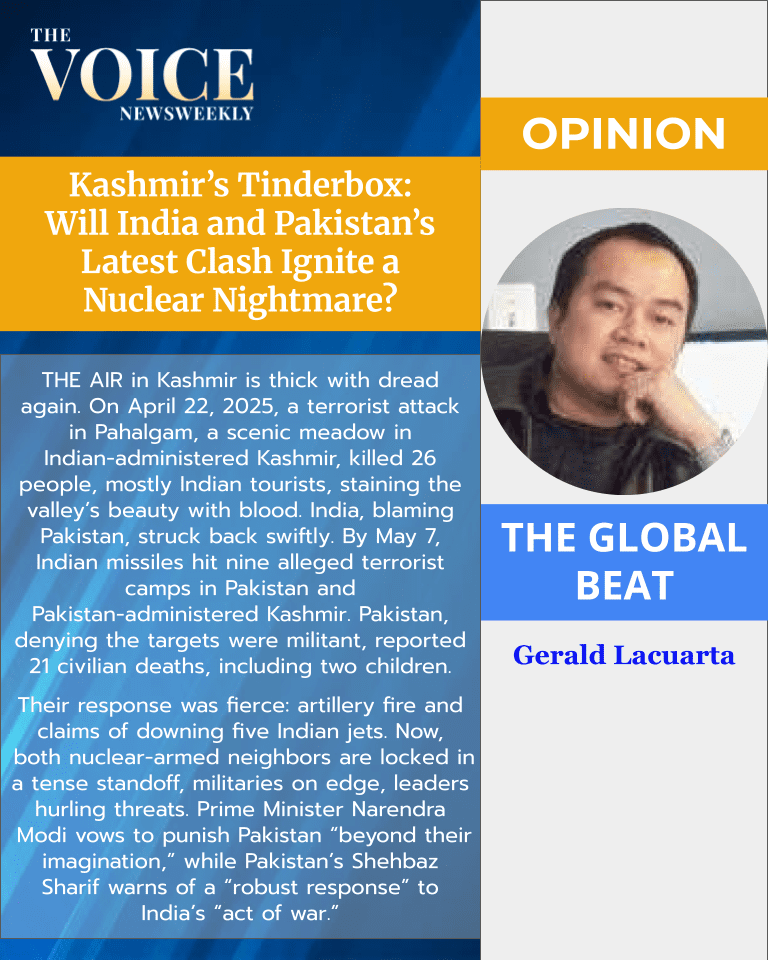𝗧𝗵𝗲 𝗚𝗹𝗼𝗯𝗮𝗹 𝗕𝗲𝗮𝘁 𝗯𝘆 𝗚𝗲𝗿𝗮𝗹𝗱 𝗟𝗮𝗰𝘂𝗮𝗿𝘁𝗮
THE AIR in Kashmir is thick with dread again. On April 22, 2025, a terrorist attack in Pahalgam, a scenic meadow in Indian-administered Kashmir, killed 26 people, mostly Indian tourists, staining the valley’s beauty with blood. India, blaming Pakistan, struck back swiftly. By May 7, Indian missiles hit nine alleged terrorist camps in Pakistan and Pakistan-administered Kashmir. Pakistan, denying the targets were militant, reported 21 civilian deaths, including two children.
Their response was fierce: artillery fire and claims of downing five Indian jets. Now, both nuclear-armed neighbors are locked in a tense standoff, militaries on edge, leaders hurling threats. Prime Minister Narendra Modi vows to punish Pakistan “beyond their imagination,” while Pakistan’s Shehbaz Sharif warns of a “robust response” to India’s “act of war.”
Here in Central Luzon, where we’ve known the scars of foreign aggression, this news lands heavily. India and Pakistan’s feud stretches back to the 1947 Partition, born from British India’s collapse. Three wars (1948, 1965, 1971) and endless skirmishes, mostly over Kashmir, a Muslim-majority region both claim fully, have kept tensions simmering. Both went nuclear, India in 1974, Pakistan in 1998, each now holding about 160-170 warheads. Kashmir isn’t just land; it’s pride, identity, and a geopolitical chessboard. Could this flare-up, the worst since 2019, spiral into the unthinkable, a nuclear war?
Flash back to 2019. A suicide bombing in Pulwama, Kashmir, killed 40 Indian soldiers. India retaliated with airstrikes on Pakistani soil, targeting “terrorist camps.” Pakistan shot down an Indian jet, captured its pilot, and the world braced for worse. Former U.S. Secretary of State Mike Pompeo later said he worked tirelessly to convince both sides no nuclear strike was imminent. Diplomacy and luck prevailed. But luck isn’t a plan, and today’s crisis feels darker. Modi’s rhetoric bites harder, Pakistan’s defenses are taut, and the 2021 ceasefire is in tatters.
What’s changed? Both militaries are stronger. Since 2019, India and Pakistan have upgraded their arsenals: more missiles, drones, aircraft. India’s deeper pockets give it a conventional edge, but Pakistan’s nuclear stockpile levels the field. Experts warn even a small conflict risks escalation. If India presses too far, Pakistan, fearing defeat, might go nuclear. A 2019 study projected a 2025 nuclear war could kill 50-125 million instantly, with 17 million tons of black carbon causing a global nuclear winter, cutting sunlight by 20-35% and slashing food production for a decade. Two billion could starve. That’s not exaggeration; it’s math.
This isn’t just South Asia’s fight. The U.S. and China have high stakes in this conflict, tied to a shifting global order. For the U.S., India is a cornerstone against China’s rise. The Trump administration’s “U.S.-India COMPACT” initiative, launched in February 2025, deepens military and tech ties, with a trade deal pending. India, a Major Defense Partner, counters Beijing’s Indo-Pacific ambitions. A Kashmir war would drain India’s focus, weaken its stance against China, and destabilize a region vital to U.S. interests. A nuclear clash would be a global disaster, threatening U.S. security and markets. Yet, Trump’s aloof approach worries analysts like John Mearsheimer, who questions the administration’s commitment to de-escalation, unlike past U.S. leaders who intervened decisively.
China, meanwhile, is Pakistan’s staunch ally. The China-Pakistan Economic Corridor, a Belt and Road linchpin, pours billions into Pakistan’s infrastructure. In February 2025, Pakistan’s President Asif Ali Zardari visited Beijing to bolster defense ties. China arms Pakistan and offers diplomatic cover, partly to keep India off balance. A full-blown India-Pakistan war tests China’s calculus: support Pakistan too much, and it risks losing India, a major trade partner; do too little, and it dents its regional clout. A nuclear war would cripple China’s economic goals, disrupting trade routes and global stability.
The geopolitics are complicated. The U.S. needs India strong but restrained; China wants Pakistan secure but not reckless. Both, alongside Gulf states and the UN, urge calm, but India and Pakistan lack robust crisis channels. Moeed Yusuf, Pakistan’s former National Security Adviser, notes they lean on third parties like the U.S. to defuse tensions. Trump’s focus elsewhere leaves a gap. Missteps, a faulty intelligence report, a stray missile, or fears of a “surgical strike” on nuclear sites, as in 1989, could ignite chaos.
Could this go nuclear? Yes, but it’s not certain. Pakistani author Harris Sultan argues generals won’t risk national suicide, even over Kashmir. Both sides know mutual destruction isn’t victory. Still, nationalist zeal and twitchy militaries aren’t comforting. In 1981, U.S. intelligence warned an Indian strike on Pakistan’s Karachi Nuclear Power Plant could release deadly radiation, killing thousands. That danger lingers.
For us in Central Luzon, this feels far yet familiar. Our history of Spanish, American, and Japanese occupations reminds us that pride and missteps can spark havoc. The lesson is clear: de-escalation is survival. India and Pakistan need backchannels, not bombs. The U.S. and China must step up, using their leverage to force talks. Here, we face our own fears, of typhoons or unrest, by leaning on community and faith. For South Asia, that means dialogue, not warheads.
What’s at stake? For India and Pakistan, it’s existence. For the U.S. and China, it’s global influence and stability. For the world, it’s dodging a nuclear abyss. Will sanity prevail, or are we one blunder from catastrophe? Let’s hope for the former, because the alternative is too grim to fathom.












